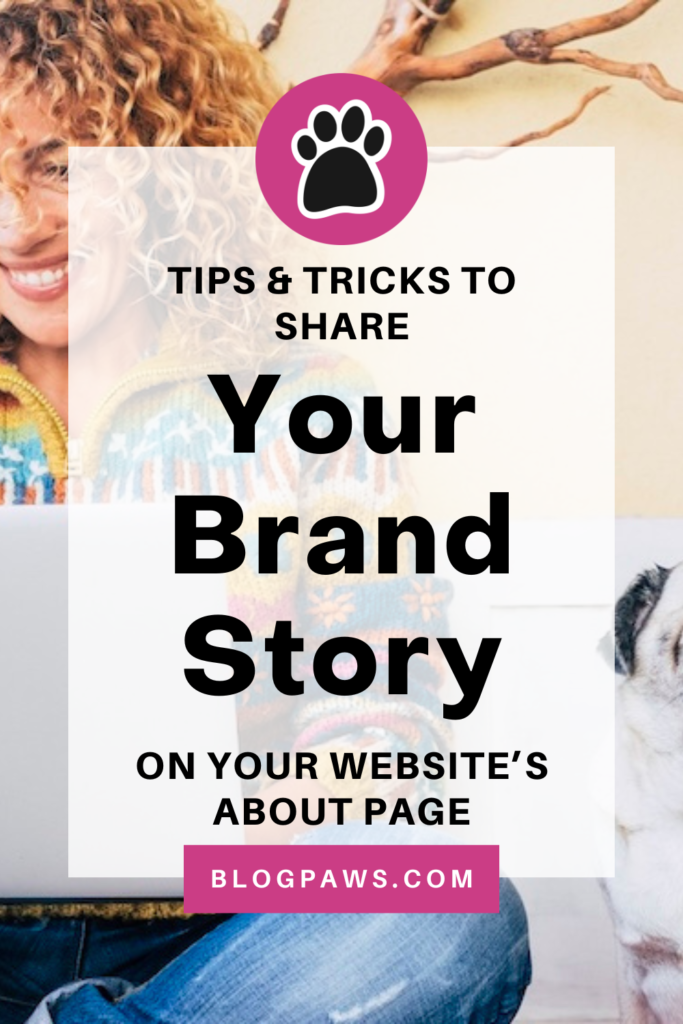Tips To Share Your Brand Story On Your About Page
Storytelling on your About Page is important for everyone – brand and people alike. As someone who has coached hundreds of speakers, leaders, and brands on their stories, I’m often asked what the ingredients are for a great story.
I wish there was a simple answer, like a recipe for baking chocolate chip cookies. Alas, there is not an easy answer to any of the questions about storytelling.
The truth is, I can’t tell you the best way to share your story without hearing all of it and asking many questions. Even then, there won’t be one answer.
What I can do is tell you that you absolutely have a story to share. I can tell you to focus on the action and the internal narrative of the story. I can tell you to avoid the parts that may be true but either create confusion or add irrelevant details. Still, there is not really one way to do all of that.
I will definitely tell you that the best stories are not first drafts.
Stories Matter For Pet Brands
Recently, BlogPaws attended Global Pet Expo, and during the hours spent on the show floor, we heard many stories from brands: stories about the brand itself, stories about the latest product they created, stories about people and/or pets using those products, and so many more.
We are storytellers—all of us.
Sure, there is a craft to choreographing a story—that’s what I call it because telling your stories should include choices, which is like choreographing a dance.
But craft or no craft, we were born to share our stories. Stories will create an emotional response, and yes, it’s the most well-crafted stories that ignite such emotion that a person is driven to action.
This is what we look for in the pieces of your story that you share on your website’s About Page, and it was those bits and pieces that we heard on the show floor at Global.
While we did not award a BlogPaws Best Award for storytelling, I did take a little time to peruse some of the winners’ About Pages to find great examples of choices you can make when sharing your story.
Storytelling Tactics For Your About Page
Reading through the About Pages for all our BlogPaws Best Award winners, I found a few tactics to share that can help you with your About Page story. These each highlight a different aspect of storytelling or “story choreography.”
First, a Quick Tip for Everyone
Stop focusing on WHAT happened. Instead, focus on how you feel about what happened. It doesn’t mean the “what” isn’t important, but you’ll find the specific details are less important than the emotional journey you went on. People will connect with the journey more than the events.
Before we dive into the tactics that work for these pet brands, it’s important to note that, like every person, every brand is different. There is no perfect formula for sharing a brand story.
But again, every brand has a story.
Tactic 1: Use a Familiar Format
Once upon a time…
It’s not only a familiar beginning to stories, especially fairytales and folktales, which means most of us have heard it all our lives, but it also helps to put us right into story mode.
Sarah, Founder of Lord Jameson, uses this format for Lord Jameson’s About Page, which begins, “Once upon a time, in a small New York City kitchen, a woman named Sarah set out to create a delicious and nutritional treat using the finest ingredients for her dog Jameson.”
Gary Bagnall, founder of Zoo Med, also uses this tactic in a similar way, starting with, “46 years in the making, Zoo Med is a story of passion and discovery. It all started with a young Gary Bagnall exploring the creek near his home in northern California and the delight he found in the bustling local habitat of frogs and toads.”
By sharing both how “it all started” and how long ago it started, we immediately know there has been a journey.
Using a format like this helps create a setting, an expectation, and helps us understand the journey that has happened between that time and now.
If you are thinking, “But you said there is no recipe!” You are right. I did, and this isn’t.
This format of “Once Upon a Time” does not tell you what to include. It just helps you start, and that can be helpful.
Tactic 2: Immediately Call Out Your Beliefs
When it comes to an About Page, there is an expectation from the reader that they will learn about your brand and the person or people behind it. When you state a belief that allows people to opt into (or opt out of) right away, you help lift the curtain of the brand. It’s like you expose the wizard immediately, and those people who are your people will immediately know it.
Dr. Lynn Bahr, Founder of Dezi & Roo, comes right out with such a statement on Dezi & Roo’s About Page, “WE BRING OUTDOOR FUN TO INDOOR CATS.”
We call this a qualifying statement. Anyone who has indoor cats is immediately, potentially, her people. And those people will probably think, “I have indoor cats!” or “I’ve always wanted my indoor cats to have outdoor fun” or something similar.
Sure, people who do not have indoor cats may read that and think, “Well, that’s not me,” and just click away, but that’s also good.
Jacqueline Prehogan, Founder and CEO of Canada Pooch, also uses this tactic with two main statements on her About Page, starting with “A Size For Every Dog” and quickly followed by “Created by a dog mom who wouldn’t compromise when it came to her pup.”
Everyone who has ever had a dog for which they struggled to find a size—whether too small or too large—has immediately tuned in.
We want our stories to connect with the right people, not all people. Stories that are for everyone end up being for no one.
This is not the same as having everyone connect with your story, but that’s a post for another day.
Tactic 3: Go Straight for the Heart
And by straight for the heart, we mean emotion. Get right into making someone feel an emotion. You get to choose what emotion – happiness, nostalgia, love, etc. – and then use words and photos to bring that emotion to life.
The Scott Family, Founders of RAWZ Natural Pet Food, immediately hits you with nostalgia on their About Page, and they lean even more into it by calling the page Our Story. The mix of decades-old photos with the words “The Scott Family” overlaid, along with the statement, “TRANSITIONING THE SOUL OF THE BUSINESS ACROSS THREE GENERATIONS,” just flames that nostalgic feeling.
Then, if you watch the embedded video, you’ll learn how RAWZ donates proceeds to help get service dogs into the hands of people who need them. Well, it’s just more feels.
In the words of Maya Angelou, “People will forget what you said. People will forget what you did. But people will never forget how you made them feel.”
Since a big reason you share your story on your About Page is so that people remember you, creating emotion is a big plus.
How Much of My Brand Story Belongs on My About Page?
This is another question for which there is no easy answer. Definitely some of it. Probably not all of it, but which pieces? You have to write it and share it to see if what you share is creating the desired effect. Only then will you know for sure if the story you are sharing is doing its job.
Every story you share has a job. The job of an About Page story is to connect with your people so that they remember you and feel inclined to take action.
Each of the examples above showed an element of storytelling that you can choose to use. You don’t necessarily need to pick just one, but you should take a minute to read your About Page. Is it doing its job?
Storytelling is one of BlogPaws’ specialties. If you’d like help with yours, reach out.
About the Author: Chloe DiVita, BlogPaws CEO, has 15+ years of experience in digital marketing, the pet industry, and as a greyhound mom. She’s earned accolades like, Pet Age’s 40 Under 40 and Muse Medallions from the Cat Writers’ Association. Formerly Executive Producer for TEDxCambridge, she brings storytelling and public speaking to her work with creators, leaders, and brands. Read more…








